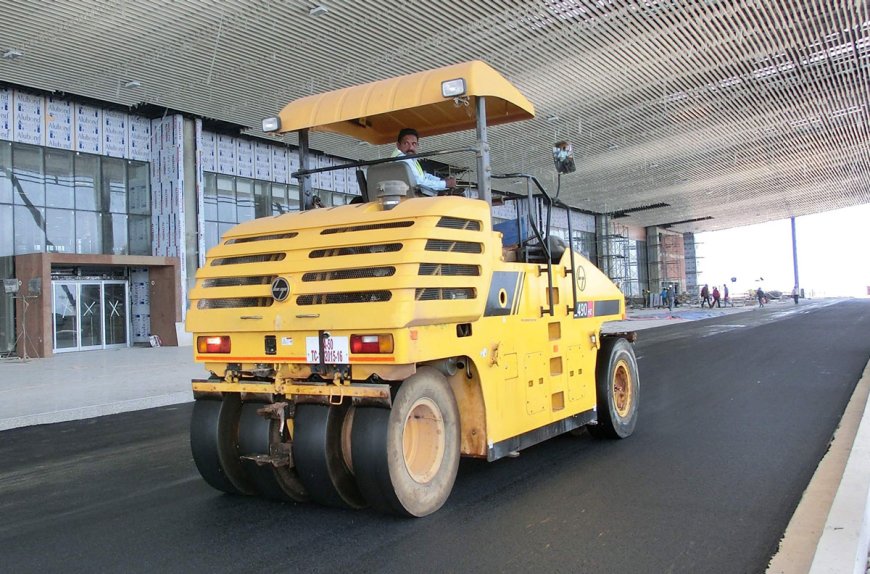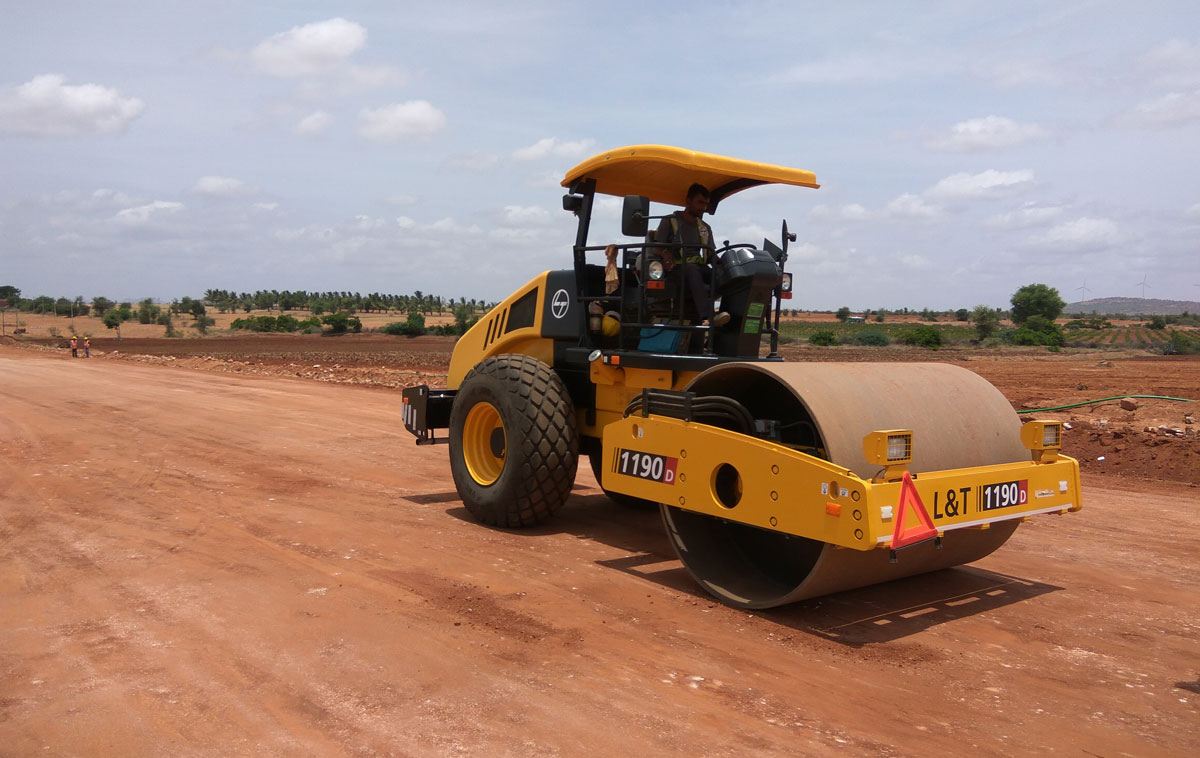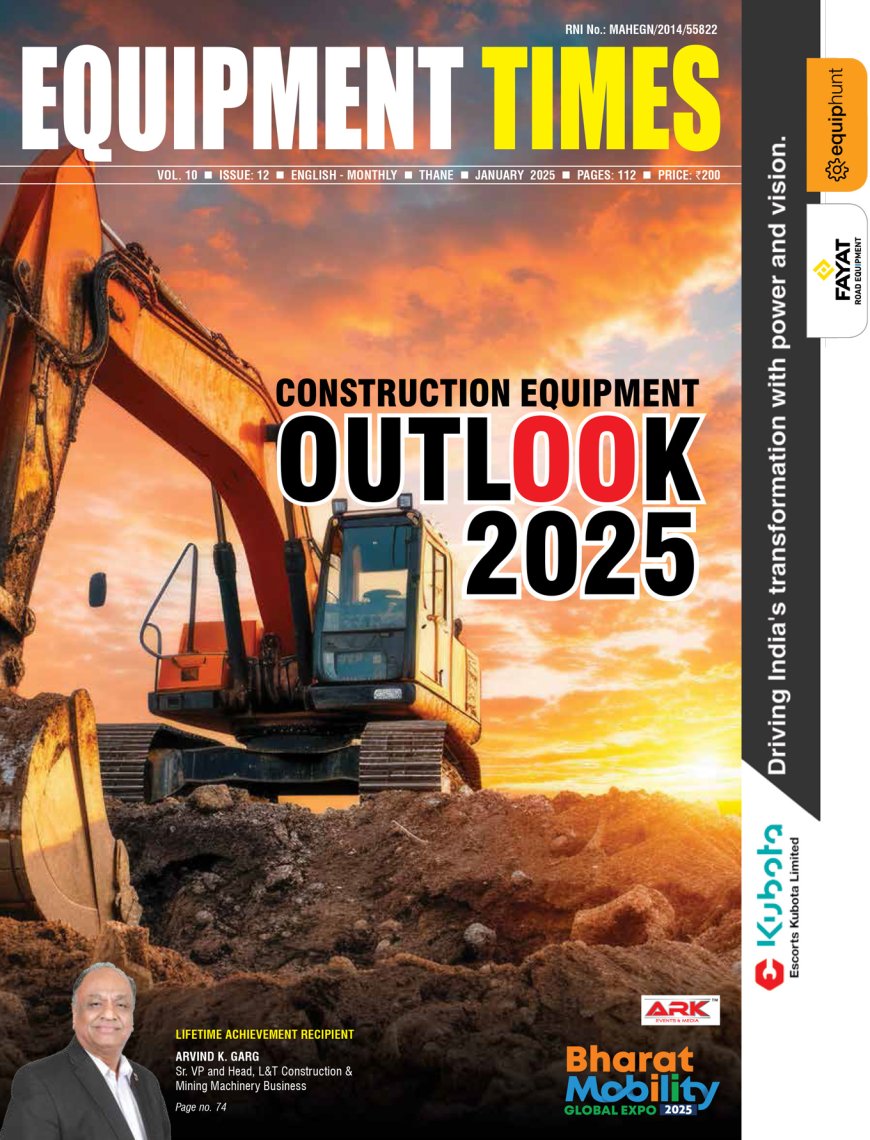Contractors will go in for specialised equipment to obtain higher productivity Road construction equipment industry is the backbone driving the Indian economy.
Road transport is vital to our economy. India has a large existing road network of over 33 lakh Km, the second largest road network in the world. There are Expressways, National Highways, State Highways, Major District roads and Rural Roads

 Road transport is vital to our economy. India has a large existing road network of over 33 lakh Km, the second largest road network in the world. There are Expressways, National Highways, State Highways, Major District roads and Rural Roads catering to a wide variety of Road users. The Government of India considers road network as critical to the country’s development, social integration and its security needs. MORTH (Union Ministry of Road Transport &Highways) has set an objective of increasing the pace of construction to 40 km of roads per day. Road construction generates primary, secondary and tertiary demand, hence, can certainly be called as “economy driver”.
Road transport is vital to our economy. India has a large existing road network of over 33 lakh Km, the second largest road network in the world. There are Expressways, National Highways, State Highways, Major District roads and Rural Roads catering to a wide variety of Road users. The Government of India considers road network as critical to the country’s development, social integration and its security needs. MORTH (Union Ministry of Road Transport &Highways) has set an objective of increasing the pace of construction to 40 km of roads per day. Road construction generates primary, secondary and tertiary demand, hence, can certainly be called as “economy driver”.
Accelerating execution rate can be done by using the best-in-class machines to deliver safe, serviceable and sustainable roads. Road Construction Equipment Industry has come a long way in employing a large workforce in factories and in the supplier base of the industry, providing jobs to equipment operators, service mechanics etc. It has been successful in converting manual work to skilled labour and thus promoting Skill India initiative as well.
With exclusive emphasis on highways through accelerated highways development program by the government, how are OEMs utilising this opportunity to contribute towards the economic growth of the country?
There are many established world leaders offering products for the Road Sector in India. Larsen & Toubro manufactures and markets a range of road making equipment such as L&T 1190/L&T 990/L&T 491 and L&T 2490 Pneumatic Tyre Rollers which are actively engaged for roads in India. These machines are part of the Make-in-India initiative and paving the way to achieve the goal of Atmanirbhar Bharat. L&T also manufactures Asphalt Pavers, Skid Steer Loaders and Wheel Loaders. Together, all these equipment contribute significantly in accelerating the road construction activity. These machines have been designed and developed by L&T indigenously and over 1500 nos. Wheel Loaders, 2000 nos. Compactors are deployed at various projects in India and neighbouring countries.
OEMs like L&T are continuously engaged with customers who use the equipment for various types of roads – village roads, urban roads, highways and accordingly could fine-tune the specifications to meet the exacting requirements. This approach has helped to bring economical and appropriate technologies in Road Construction.
How has the Rs 20 lakh crore economic stimulus package to deal with the fallout of the Coronavirus pandemic affected OEMs?
The revival in demand of construction equipment will depend primarily on the pace of execution of the projects. MORTH is giving thrust on infrastructure segment. We have seen that large road contracts are being awarded even during the lockdown. NHAI is looking at awarding 8000 km highway construction contracts in FY2020-21. While the stimulus package is largely focussed on easing credit flow, which will certainly support revival of the economy in general. However, we expect the demand gradually pick up from Q3onwards. Return of workers and execution pick up will bring back customer to buy road machinery. Credit support in the stimulus package has helped MSMEs who are largely suppliers to OEMs to stay afloat during the pandemic. The change in the definition of MSMEs will help some of the suppliers to grow without much constraints.
What are your views on the Ministry of Road Transport and Highways (MoRTH) considering to defer implementation of BS-IV emission norms for construction equipment vehicles?
We think it is a very good move from MORTH. The pandemic has hit the BS-IV implementation in many ways. While all the OEMs are at various stages of testing and validating the implementation, these activities were disrupted due to the lockdown. The equipment have to be tested at Construction sites which were affected as well. Also, due to the pandemic and lockdown, the demand for various equipment has dropped substantially. The plans for tapering down the production of BS-III machines were affected, impacting inventories in Finished Goods and components. Also, the supply of components for BS-IV got disrupted. Hence, deferring the implementation of BS-IV is a good move and will help the already strained industry and its associated dependents.
The BS-IV norms for construction equipment vehicles was to come in force from 1st April and the notification for suggestions from stakeholders has been published by MORTH.While we are closely working with Engine OEMs, and trials are on, there is a process of validation to be followed with various testing agencies. ARAI will surely extend help by expediting the validation. These BS-IV norms make the equipment more environment friendly.
Do you see Chinese companies ban on Indian highway projects as an opportunity?
Chinese companies had started bidding for certain sections of tunnel jobs in highway projects. The current situation will make it difficult for the Chinese companies to get projects awarded in India. There are a lot of Chinese machinery and equipment for which we will need to find viable local alternatives to truly become Atmanirbhar. It will also help Indian companies to develop Road Construction and Bridge Construction equipment indigenously which otherwise would not happen. This has been the success formula of China which has developed various equipment required for its economy by themselves. While India has technology for Chandrayaan, is it not high-time, we develop equipment for Road Construction ourselves? I am sure the Government will support these initiatives.
What kind of policy initiatives or reforms do you expect from the government to support Indian manufacturers?
The Government along with the Industry body like ICEMA can prepare a strategy identifying the future construction methods, equipment requirements, what can be locally produced, what needs to be imported with a 10-year horizon and throw open the field for such identified products to be locally produced in an economical manner. This will help Indian manufacturers to channelize their efforts in locally producing those identified equipment. Standardisation of Construction methods and the equipment specification will help generate volumes, which is essential to make localisation viable. Further, there has to be a longer-term sustainability of demand for local manufacturing to develop and flourish. Periodic demand shocks impact the industry attractiveness.
The Indian manufacturers are doing very well in a wide variety of segments which include Tractors, Two Wheelers, Automobiles, Light Engineering Goods. These industries have dedicated vendors and over a period the entire eco -system has developed. The government may consider providing the basic infrastructure and ensuring continuity of the policy framework. L&T has a lot of manufacturing experience with Construction machinery. L&T pioneered the concept of Vibratory Compactors in India in 1976. L&T also indigenously manufactures hydraulic equipment, many of the hydraulic motors and cylinders on the construction machines being manufactured in-house.
Could you tell us about the different schemes initiated by the government to boost the construction activities in the country?
MoRTH is keen on increasing the pace of road construction. Agencies like NHAI, NHIDCL etc are involved with schemes like Bharatamala, Sagarmala, Chardham etc. Further, there is a huge National Infra Pipeline worth Rs 100 L crore to be completed by 2025. When these projects are implemented the construction equipment demand would start growing. Hence, implementation is the key. Further, finance availability for these projects and equipment is essential, which is the current challenge facing the industry. Banks and NBFCs have to become more liberal in finding CE and give higher priority to the construction sector.
Labor movement and supply chain disruption was considered a major hindrance to project execution. What steps have you taken to overcome these challenges?
Recovery of demand will certainly depend on factors such as availability of labour and skilled work force, liquidity with customers, payments from authorities and ability of financers to fund CE. etc. The demand is expected to pick up from Sept onwards. Komatsu, Scania and L&T are geared to meet the requirements. Our after-sales service teams are already active and rendering service and supplying parts across India wherever machines are operational. All our Service Centres located at Kanchipuram, Butibori, Wagoli, Durgapur, Singaruli and Bahadurgarh are operational.
Are you experiencing a decline or increase in demand for any road equipment in the wake of the ongoing pandemic? How is it impacting the business prospects and project execution?
The demand for the construction equipment contracted during the last financial year received a serious blow with lockdown due to COVID19. Now with phased unlocking in many states, work on many projects have commenced and the demand is slowly picking up. However, we have to wait to see if the demand sustains.
What kind of support do you expect from the government to boost the road equipment sector in the country?
We as a country are still dependent on the Government to fund Infra Projects. Large private sector investments in the Infrastructure projects will take some time, though many large projects have come up in PPP mode in the last few years. If the Government ensures a steady flow of project awards across the sectors like Irrigation, Airports, Roads, Power, Housing etc., it will ensure a steady demand for the construction equipment too.
Tell us about the key developments in the road equipment sector?
The Road Equipment offered in India are of the same standards which any contractor would use in a developed country. The machine utilisation is high in India as contractors try to maximise the output from each of the machine which they deploy. The digitalisation in the form of Vehicle Health Monitoring Systems are being integrated into the equipment. The need of the customers in India is unique and accordingly, simple machines with high reliability and durability with cost effective designs are being pursued.
In your view, is the infrastructure development in the country conducive for future growth?
The Prime Minister had projected India to be a 5 Trillion Dollar Economy. To achieve such a growth, the infrastructure – Ports, Highways, Railways, Airports and Metros will have to be developed at a faster pace. The development of infrastructure is a key for sustained growth. A poorly connected port will pull down the productivity of a large section of the country due to delayed shipments.
What are your future projections for the Indian road equipment sector?
The Indian Road Equipment sector will see a steady growth in the years to come. We feel contractors will go in for specialised equipment like Crusher Buckets, Slope Compactors, Demolition Tools and Rock Breakers in a big way to expedite the construction activities and obtain higher productivity.

Hits: 76










